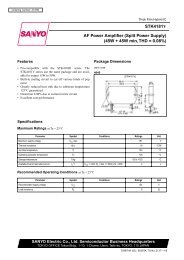TDA7375 - Laro
TDA7375 - Laro
TDA7375 - Laro
You also want an ePaper? Increase the reach of your titles
YUMPU automatically turns print PDFs into web optimized ePapers that Google loves.
<strong>TDA7375</strong><br />
Figure 21. Total Power Dissipation and<br />
Efficiency vs. Output Power<br />
Figure 22. Total Power Dissipation and<br />
Efficiency vs. Output Power<br />
5 GENERAL STRUCTURE<br />
5.1 High Application Flexibility<br />
The availability of 4 independent channels makes it possible to accomplish several kinds of applications<br />
ranging from 4 speakers stereo (F/R) to 2 speakers bridge solutions.<br />
In case of working in single ended conditions the polarity of the speakers driven by the inverting amplifier<br />
must be reversed respect to those driven by non inverting channels. This is to avoid phase inconveniences<br />
causing sound alterations especially during the reproduction of low frequencies.<br />
5.2 Easy Single Ended to Bridge Transition<br />
The change from single ended to bridge configurations is made simply by means of a short circuit across<br />
the inputs, that is no need of further external components.<br />
5.3 Gain Internally Fixed to 20dB in Single Ended, 26dB in Bridge<br />
Advantages of this design choice are in terms of:<br />
■ componentsand space saving<br />
■ output noise, supply voltage rejection and distortion optimization.<br />
5.4 Silent Turn On/Off and Muting/Stand-by Function<br />
The stand-by can be easily activated by means of a CMOS level applied to pin 7 through a RC filter.<br />
Under stand-by condition the device is turned off completely (supply current = 1µA typ.; output attenuation<br />
= 80dB min.). Every ON/OFF operation is virtually pop free. Furthemore, at turn-on the device stays in<br />
muting condition for a time determined by the value assigned to the SVR capacitor.<br />
While in muting the device outputs becomes insensitive to any kinds of signal that may be present at the<br />
input terminals. In other words every transient coming from previous stages produces no unplesantacoustic<br />
effect to the speakers.<br />
5.5 STAND-BY DRIVING (pin 7)<br />
Some precautions have to be taken in the definition of stand-by driving networks: pin 7 cannot be directly<br />
8/15















